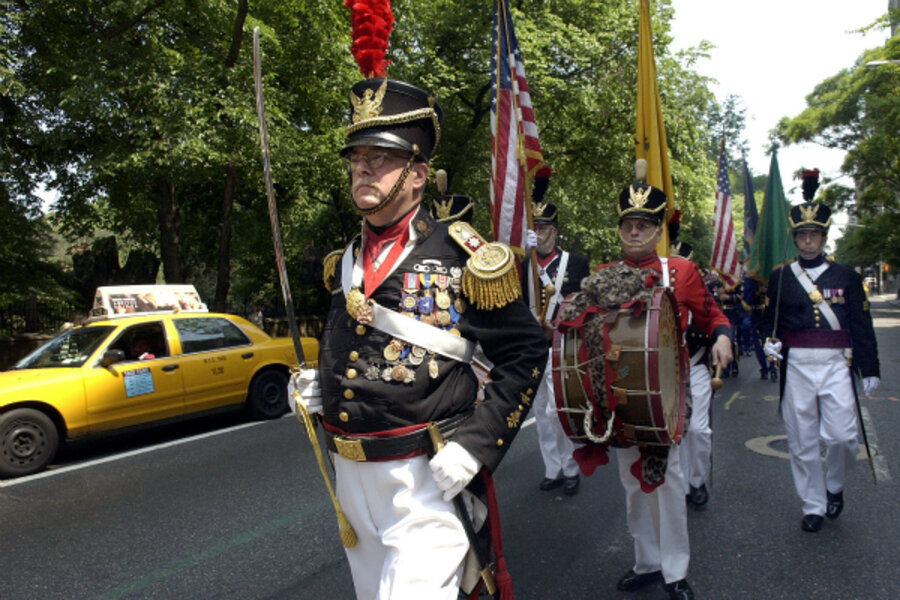Betty Oderwald helps save a memory in stone of a 200-year-old forgotten US war
Loading...
The Powder House in Fairfield, Conn., is one of the state’s few surviving witnesses to the War of 1812.
The stone structure stored ammunition during what has been called the "second war of independence" or the Forgotten War. Over time it fell into disrepair, stones were askew, the door had nearly rotted away, and the property was overgrown.
Then Betty Oderwald came on the scene.
As president of the Connecticut Society of US Daughters of 1812, Ms. Oderwald raised local awareness and prevented the town and state from losing this structure.
Together with Connecticut's Society of The War of 1812, the Fairifeld Daughters of the American Revolution (DAR), and the Fairfield public works department, and with $5,000 from town funds, Oderwald was able to provide the cottage-like stone building with a new roof and new door. Its stones were also realigned and cleaned.
It was an important endeavor because the Powder House is thought to be the only structure in Connecticut built expressly for the War of 1812 that is still standing, Oderwald says.
US President James Madison signed a declaration of war against Great Britain on June 18, 1812. Britain had steadfastly rejected America’s right to engage in free and unfettered transatlantic commerce. It routinely boarded American vessels and pressed American sailors into the Royal Navy.
The small building was built in 1814, two years after the war began, according to minutes from Fairfield’s 1814 town meeting. Fairfield citizens didn’t become truly worried that their town might be a target for British troops until 1814.
“[French leader] Napoleon [Bonaparte] had abdicated, and Britain could now turn all its forces on America with a kind of burn-them-out mentality. At that point, it became crucial that you had adequate defenses,” Oderwald says. “Britain always had ships going up and down Long Island Sound. The citizens really knew [a raid] could happen.”
In 1814 the British burned Washington, D.C., including the White House and US Capitol, and bombarded Fort McHenry in Baltimore harbor (inspiring Francis Scott Key to write the words for "The Star Spangled Banner"). In December 1814 the battle of New Orleans was fought after the official end of hostilities.
In 2012, the National Society of the Daughters of the American Revolution (DAR) presented the Fairifeld DAR with a historic preservation award for its renovations to the Powder House.
Oderwald wants residents across the state to appreciate the building's history. She is working to have the Powder House listed on the National Register of Historic Places. But first it must be listed on the State Register of Historic Places.
Oderwald gives tours to local schoolchildren and lectures at historical societies across the state to raise awareness and interest.
Ironically, Fairfield never used the Powder House. The state of Connecticut so opposed the war with Britain that Gov. Roger Griswold prohibited the state’s militia from serving beyond the state’s borders. Some 5,000 Connecticut men served in the war, but only to defend the state's own borders and coast.
Oderwald’s interest in the Connecticut militia has led her to initiated yet another project. She wants to compile a list of 1812 veterans buried in cemeteries in the state’s 169 towns and cities.
While tracking down the names and burial spots for these veterans isn’t easy, she has had help from other members of the Connecticut Society as well as members of the DAR. They scour books, including “An Index of Veterans of Connecticut during the Years 1812, 1813, 1814,1815, 1816." Oderwald then cross-references those names with state militia rolls.
Oderwald hopes each veteran of the War of 1812 can be recognized in this bicentennial year.
“If the War of 1812 is the Forgotten War,” Oderwald says, “then it follows that the veterans of the War of 1812 are the forgotten veterans.”
• Sign up to receive a weekly selection of practical and inspiring Change Agent articles by clicking here.







